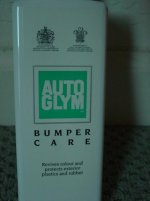Merlin
Experienced Member
It was a baiting post, not a typo; I have been waiting for you to take me on with the science part.......:mrgreen:
:lol:
:lol:
The only ways I know to fix that are either black liquid shoe polish or matt black paint; the whitening is irreversible as far as I know, unless someone wants to prove me wrong.....

Just to show how much of an anorak I have become about this topic....
Have you ever seen black bumpers (fenders) on cars, that gradually turn grey then white under sunlight? Well, that's because the bumpers are made of...yes, you've guessed it.... ABS.
The years of direct UV light gradually degrade any free double bonds from the butadiene parts of the ABS down to the hydroperoxide and the manufacturer's don't put enough carbon black pigment into the material to mask this.
The only ways I know to fix that are either black liquid shoe polish or matt black paint; the whitening is irreversible as far as I know, unless someone wants to prove me wrong.....
@ Terry Yager
You go ahead son, make your millions from restoring plastics...
@ Lorne
I am really interested with your recipe experiments, it will be good to compare with the work Tezza has done. It's also interesting that you have costed the difference out of using the gel rather than the liquid, that's a big difference and much more than I thought it would be.
Give what you've said Lorne, would you recommend not painting/masking the black areas?
Tez
Tez
@ Lorne
The Wiki has been spruced up some more now based on your comments, thanks. It should read more logically now.
Thanks
All is not lost, though; he said that if he wets the case, the white bloom disappears; if he coats the case with a clear acrylic lacquer, it should mask the bloom.
This is definitely something to watch out for if you are in a hot climate and I'll add it to the Wiki later. I think we need a "Problems and Pitfalls" section to warn people about things that could go wrong and how to avoid them.
